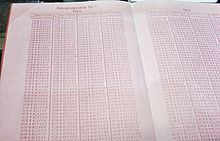Short signal booklet

The short signal booklet was a code book that was used by the submarines of the German Navy during the Second World War to encrypt and shorten their radio messages .
history
The key machine Enigma was primarily used to keep the radio communications between the commander of the U-Boats (BdU) and the German U-boats sunk in the Atlantic and Mediterranean allied ships and convoys secret .
Since the danger of the discovery and location of the submarines by Allied radio direction finding (" Huff-Duff ") was recognized when sending longer messages, and also for reasons of data compression to increase the security of the encryption (see also: Entropy ), the aim was to to send only short sayings. The short signal booklet was used for this purpose, in which, as is customary with code books, a number of terms, messages or sentences that are frequently required in routine radio communication were compared with corresponding secret letter combinations. The short signal booklet was around 100 pages long and contained a tabular list of signal groups (four letters) and phrases. The table shows some examples from the non-fiction book Deciphered Secrets :
AAAA Beabsichtige gemeldete Feindstreitkräfte anzugreifen AAEE Beabsichtige Durchführung Unternehmung wie vorgesehen AAFF Beabsichtige Durchführung Unternehmung mit vollem Einsatz AAGG Beabsichtige Durchführung Unternehmung unter Vermeidung vollen Einsatzes
Instead of a detailed report such as Intentional implementation of the company as planned , only the four letters AAEE were encrypted with the Enigma and then sent via radio together with other encrypted information, such as position and sender, which were also coded with similar tables from the short signal booklet before the encryption .
The individual signal groups of four letters always differed in at least two letters. Furthermore, the alphabetical difference between the first and the second letter was identical to the difference between the third and fourth ( "redundant coding" ). This served the purpose of "disassemblability". If a letter was "mutilated" due to a typographical or hearing error or a malfunction in the radio transmission of the short signal, that is, it was exchanged for another, this could be recognized and corrected by the short signal.
In the course of time different editions of the Kurzsignalhefts were used, for example the edition 1941 and the edition 1944. A detailed representation (in English) with some authentic pictures from the Kurzsignalheft 1944 can be found on the internet site of Dirk Rijmenants.
It was fatal for the Germans that by hijacking the U 110 submarine on May 9, 1941 , the British were not only able to capture an intact Enigma-M3 key machine , but also all of their secret documents, including the short signal booklet and the short weather key , fell into the hands and this was not noticed by the German leadership. The code crackers in Bletchley Park , England , succeeded in breaking the M3's encryption and deciphering the German submarine radio messages.
There was an interruption in the ability to decipher (“black-out”) when the M3 was replaced by the Enigma-M4 on February 1, 1942 . In contrast to the M3, this has not only three, but four rollers that are used for encryption. The black-out could only be overcome after the British destroyer HMS Petard managed to land the German submarine U 559 in the Mediterranean on October 30, 1942 and to capture the current versions of the short signal booklet and weather code.
Movies
A "Kurzsignalheft 1941" can be seen in the British feature film Enigma - The Secret , which is based on the novel Enigma and deals with the deciphering work of the British code breakers from Bletchley Park. The original showpiece from the Bletchley Park Museum is an authentic German book that was captured by a German submarine during World War II. The various radio messages have also been realistically generated and encrypted for the film according to the original rules and procedures.
literature
- Arthur O. Bauer: Radio direction finding as an Allied weapon against German submarines 1939-1945. Self-published, Diemen Netherlands 1997, ISBN 3-00-002142-6
- Friedrich L. Bauer : Deciphered Secrets. Methods and maxims of cryptology. 3rd, revised and expanded edition. Springer, Berlin et al. 2000, ISBN 3-540-67931-6 .
- Heinz Ulbricht: The Enigma cipher machine - deceptive security. A contribution to the history of the intelligence services. Dissertation Braunschweig 2005, PDF; 4.7 MB
Web links
- Authentic cover of the short signal booklet 1944
- The different types of submarine radio messages Excerpts from the book by Arthur O. Bauer (PDF file; 378 kB)
- Description (in English) of the short signals with authentic images
- Description (in English) of the capture of the short signal booklet from U 559
- Directory of secret regulations for the Enigma
supporting documents
- ↑ Friedrich L. Bauer: Deciphered secrets. Methods and maxims of cryptology. 3rd, revised and expanded edition. Springer, Berlin et al. 2000, p. 74.
- ↑ Dirk Rijmenant's description (in English) of the short signals
- ↑ Robert Harris: Enigma . Novel. Weltbild, Augsburg 2005, ISBN 3-89897-119-8 .
- ^ Tony Sale: Making the Enigma ciphers for the film "Enigma" . Retrieved June 6, 2011.